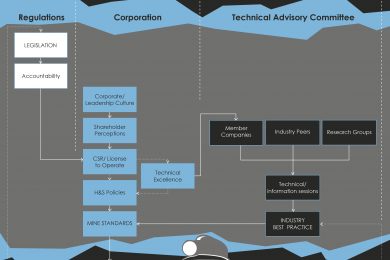According to Global Mine Design Ltd: “The phrase ‘Zero Harm’ is a widely used strapline throughout the mining industry as we try to combat having reached, statistically at least, a safety plateau. Internationally the number of injuries recorded decreased from 3,138 in 2015 to 2,662 in 2016, but this rate has slowed compared to previous years. The major causes of fatalities were still fall-of-ground incidents at 33%; slip and fall, falls from heights and fires together accounted for 21% and transport factors accounted for 14%.
Global Mine Design Ltd says it is working to positively change the approach to mine design. “Our approach, of using integrated monitoring networks to reinforce safe working conditions and provide input for ongoing data-driven mine planning decisions, is based on experience we’ve gained from years of monitoring excavation response in challenging active ground conditions. Our expertise is used to help mine sites design ground support systems and create safe work protocols.”
When talking about Health and Safety in general it would be fair to shine the spotlight on South Africa, where the legacy from earlier attitudes to worker safety still resonates in the drive to continually improve safe mining conditions. The South African Department of Mineral Resources (DMR) shows fatalities falling from 112 in 2012 to 93 in 2013, 84 in 2014 and 77 in 2015; 73 deaths were recorded in 2016.
Warren Beech (Head of Mining at Hogan Lovells in Johannesburg, South Africa), in his recent interview with Mining Weekly, explained his belief that two major factors are behind poor health and safety performance in South Africa’s mining industry: “The primary issue is behaviour – the attitude and approach to health and safety at mining operations. The key to addressing behaviour is internalising a sense of safety. Health and safety at mines needs to go beyond implementation on site only, and needs to be embedded as common practice by all mine staff [regardless of whether they are at home or at work]. For example, vehicle speed limits, although mostly adhered to at mine sites, are quickly disregarded as soon as personnel leave the site, as enforcement is drastically reduced and the threat of being caught is less probable.”
He adds: The second issue is the general instability in the mining sector, which affects the morale of mine management and staff, including political insecurity nationally and job insecurity as well as general commercial insecurity in the mining industry, with depressed commodity prices and variable demand from the once thriving primary markets… The mines went through major restructuring as a result of the international commodities downturn . . . in terms of demand and prices. Restructuring impacts on work teams, including supervision, the sense of camaraderie and smooth workflow.”
Global Mine Design believes it can see elements of these issues throughout the global mining industry. In the UK, for example, the Health and Safety Executive published revised Mines Regulations in 2014 with emphasis on producing a single, modern set of regulations that are focussed on the control of risks from major hazards in mines. This is a timely update of the regulations, with the recent opening of Wolf Minerals’ Drakelands Mine and several other exciting mining prospects in the UK, such as Strongbow Exploration’s work to re-open the South Crofty tin mine in Cornwall, and Galantas Gold Corporation’s expansion of the Cavanacaw Mine in Northern Ireland. In Canada, the Ontario Ministry of Labour published a Mining Health, Safety and Prevention Review in March 2015 that focussed on continuous improvement of occupational health and safety needs in the mining sector.
So, while great inroads are being made in terms of legislation and policy making, there is a long journey between legislation and ‘boots on the ground’ worker safety. “Global Mine Design always has an eye for the practical application of safe, economic, and productive mine design, and part of that comes from seeing the implementation of safety practices across multiple mining jurisdictions around the world.”
Global Mine Design gets involved with Mine Standards in three very important ways. “As auditors, we help mines review their current Ground Control Management and Mine Design standards to determine if they are up to date and effective in the workforce; if standards need improving, we help the site adopt Change Management procedures to track important changes in protocols. As technical and subject matter experts we help mines understand the critical and influential ground conditions and material properties that influence the rockmass response to mining; understanding how the mine may respond to the extraction plan allows the risks and benefits associated with different options to be considered before committing. As members of Technical Advisory Committees in various mining jurisdictions around the world our staff help share best practice; technical groups and committees are critical to feed ideas and information amongst peers – communication of good and bad experiences helps raise the overall standard of mine safety standards.”










